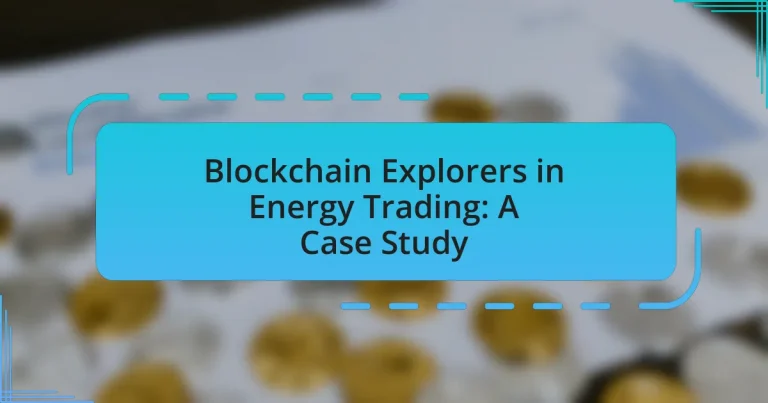Blockchain explorers in energy trading are essential tools that enhance transparency and efficiency by allowing users to view and analyze transactions on energy-specific blockchains. These explorers provide real-time access to transaction data, enabling stakeholders to track energy trades, verify authenticity, and ensure regulatory compliance. The article explores the technologies underpinning blockchain explorers, their role in improving transaction speed and reducing costs, as well as the challenges they face, including scalability and regulatory issues. Additionally, it highlights key case studies demonstrating successful implementations and discusses future trends that may influence the adoption of blockchain explorers in the transition to renewable energy sources.
What are Blockchain Explorers in Energy Trading?
Blockchain explorers in energy trading are tools that allow users to view and analyze transactions recorded on a blockchain specific to energy markets. These explorers provide transparency by displaying transaction details, such as timestamps, amounts, and involved parties, enabling stakeholders to track energy trades and verify the authenticity of transactions. For instance, platforms like Energy Web Chain utilize blockchain explorers to enhance visibility and trust in renewable energy trading, facilitating peer-to-peer energy exchanges and ensuring compliance with regulatory standards.
How do Blockchain Explorers function within the energy trading sector?
Blockchain explorers function within the energy trading sector by providing transparent access to transaction data on blockchain networks. They enable stakeholders, such as energy producers, consumers, and regulators, to track energy trades, verify transactions, and ensure compliance with regulations. For instance, blockchain explorers can display real-time data on energy generation and consumption, allowing for efficient peer-to-peer energy trading. This transparency helps build trust among participants and enhances the overall efficiency of energy markets.
What technologies underpin Blockchain Explorers in energy trading?
Blockchain explorers in energy trading are primarily underpinned by distributed ledger technology (DLT), smart contracts, and cryptographic algorithms. Distributed ledger technology enables secure and transparent record-keeping of energy transactions across a decentralized network, ensuring that all participants have access to the same data. Smart contracts automate the execution of agreements between parties, reducing the need for intermediaries and enhancing efficiency. Cryptographic algorithms provide security and integrity to the data, ensuring that transactions are tamper-proof and verifiable. These technologies collectively facilitate real-time tracking, auditing, and settlement of energy trades, thereby enhancing trust and reducing costs in the energy trading ecosystem.
How do Blockchain Explorers enhance transparency in energy transactions?
Blockchain explorers enhance transparency in energy transactions by providing real-time access to transaction data on a public ledger. This visibility allows stakeholders, including consumers and regulators, to verify the authenticity and trace the flow of energy from production to consumption. For instance, blockchain explorers display transaction details such as timestamps, amounts, and involved parties, which helps in auditing and ensures accountability. The immutable nature of blockchain records further guarantees that once a transaction is recorded, it cannot be altered, thereby preventing fraud and enhancing trust among participants in the energy market.
What role do Blockchain Explorers play in energy trading efficiency?
Blockchain explorers enhance energy trading efficiency by providing transparent and real-time access to transaction data on blockchain networks. They allow stakeholders to track energy trades, verify transaction authenticity, and monitor the flow of energy assets, which reduces the risk of fraud and increases trust among participants. For instance, a study by the International Energy Agency highlights that transparency in energy transactions can lead to a 20% reduction in operational costs, demonstrating the significant impact of blockchain explorers on trading efficiency.
How do they reduce transaction costs in energy trading?
Blockchain technology reduces transaction costs in energy trading by enabling direct peer-to-peer transactions without intermediaries. This decentralization minimizes fees associated with traditional trading platforms and reduces the time required for transaction settlements. For instance, a study by the International Energy Agency highlights that blockchain can lower transaction costs by up to 30% by streamlining processes and enhancing transparency. Additionally, smart contracts automate and enforce agreements, further decreasing administrative costs and the potential for disputes.
What impact do they have on transaction speed and reliability?
Blockchain explorers significantly enhance transaction speed and reliability in energy trading by providing real-time visibility and verification of transactions. The decentralized nature of blockchain technology allows for faster processing times compared to traditional centralized systems, as transactions can be validated simultaneously by multiple nodes. For instance, studies have shown that blockchain can reduce transaction times from days to minutes, thereby increasing efficiency. Additionally, the immutable ledger ensures that once a transaction is recorded, it cannot be altered, which bolsters reliability and trust among participants in the energy trading market. This combination of speed and reliability is crucial for the dynamic nature of energy trading, where timely and accurate transactions are essential for operational success.
What challenges do Blockchain Explorers face in energy trading?
Blockchain Explorers face several challenges in energy trading, primarily related to scalability, regulatory compliance, and data privacy. Scalability issues arise because blockchain networks can struggle to handle the high transaction volumes typical in energy markets, leading to delays and increased costs. Regulatory compliance is another significant challenge, as energy trading is heavily regulated, and blockchain technology must align with existing laws and regulations, which can vary widely by region. Additionally, data privacy concerns emerge since energy trading involves sensitive information that must be protected while still allowing for transparency and traceability, which are core benefits of blockchain technology. These challenges hinder the widespread adoption and effectiveness of blockchain solutions in the energy trading sector.
How do regulatory issues affect the implementation of Blockchain Explorers?
Regulatory issues significantly hinder the implementation of Blockchain Explorers by creating compliance challenges and uncertainty in the legal framework. These challenges arise from varying regulations across jurisdictions, which can complicate the development and deployment of blockchain technology in energy trading. For instance, regulations concerning data privacy, anti-money laundering, and securities can impose strict requirements on how Blockchain Explorers operate, potentially limiting their functionality and accessibility. Additionally, the lack of standardized regulations can lead to inconsistent practices, making it difficult for developers to ensure compliance and for users to trust the technology. This regulatory landscape can slow down innovation and adoption, as companies may hesitate to invest in solutions that could face legal obstacles.
What are the technological barriers to widespread adoption?
The technological barriers to widespread adoption of blockchain in energy trading include scalability, interoperability, and security concerns. Scalability issues arise because many blockchain networks struggle to handle a high volume of transactions efficiently, which is critical for real-time energy trading. Interoperability challenges exist as different blockchain platforms may not communicate effectively with one another, hindering seamless integration across various systems. Security concerns are significant, as vulnerabilities in smart contracts or the underlying blockchain technology can lead to potential fraud or data breaches, undermining trust in the system. These barriers must be addressed to facilitate broader acceptance and implementation of blockchain solutions in the energy sector.
How are Blockchain Explorers transforming the energy trading landscape?
Blockchain explorers are transforming the energy trading landscape by providing transparent, real-time tracking of energy transactions. This transparency enhances trust among participants, reduces fraud, and streamlines the trading process. For instance, blockchain explorers enable peer-to-peer energy trading by allowing users to verify transactions without intermediaries, which can lower costs and increase efficiency. According to a report by the International Energy Agency, blockchain technology can facilitate decentralized energy systems, promoting renewable energy integration and enhancing grid resilience.
What are the key case studies showcasing Blockchain Explorers in action?
Key case studies showcasing Blockchain Explorers in action include the Energy Web Foundation’s project in the energy sector, which utilizes blockchain technology to enhance transparency and efficiency in energy trading. This initiative demonstrates how Blockchain Explorers can track energy transactions in real-time, ensuring data integrity and reducing operational costs. Another significant case study is the Power Ledger platform, which enables peer-to-peer energy trading, allowing consumers to buy and sell excess renewable energy directly. These examples illustrate the practical application of Blockchain Explorers in facilitating decentralized energy markets and improving transaction processes.
What lessons can be learned from successful implementations?
Successful implementations of blockchain in energy trading demonstrate the importance of stakeholder collaboration. Effective communication among participants, including energy producers, consumers, and regulators, fosters trust and transparency, which are critical for the adoption of new technologies. For instance, the Energy Web Foundation’s projects have shown that engaging all stakeholders early in the process leads to smoother integration and operational efficiency. Additionally, successful implementations highlight the necessity of robust technological infrastructure; projects that invested in scalable and secure systems, such as those utilizing Ethereum or Hyperledger, have reported higher success rates. These cases illustrate that aligning technological capabilities with market needs is essential for achieving desired outcomes in energy trading.
How do these case studies illustrate the potential of Blockchain Explorers?
These case studies illustrate the potential of Blockchain Explorers by demonstrating their ability to enhance transparency, traceability, and efficiency in energy trading. For instance, the integration of Blockchain Explorers allows stakeholders to track energy transactions in real-time, ensuring that all parties have access to the same data, which reduces disputes and increases trust. Additionally, the case studies show how Blockchain Explorers facilitate automated smart contracts, streamlining the trading process and minimizing transaction costs. This is evidenced by specific implementations where energy trading platforms reported a reduction in settlement times from days to minutes, showcasing the transformative impact of Blockchain Explorers in the energy sector.
What future trends can we expect for Blockchain Explorers in energy trading?
Future trends for Blockchain Explorers in energy trading include increased integration of decentralized finance (DeFi) solutions, enhanced transparency through real-time data sharing, and the adoption of smart contracts for automated transactions. The rise of DeFi will enable peer-to-peer energy trading, allowing consumers to buy and sell energy directly, thus reducing reliance on traditional energy markets. Real-time data sharing will improve market efficiency and trust among participants, as blockchain technology ensures that all transactions are recorded transparently and immutably. Additionally, smart contracts will facilitate automated and secure transactions, minimizing the need for intermediaries and reducing transaction costs. These trends are supported by the growing interest in renewable energy sources and the need for more efficient energy distribution systems, as evidenced by initiatives like the Energy Web Foundation, which aims to accelerate the transition to a decentralized energy system.
How might advancements in technology influence Blockchain Explorers?
Advancements in technology can significantly enhance Blockchain Explorers by improving their efficiency, user interface, and data analytics capabilities. For instance, the integration of artificial intelligence can enable real-time data processing and predictive analytics, allowing users to make informed decisions based on transaction trends and patterns. Additionally, advancements in cloud computing can facilitate faster access to blockchain data, enabling Blockchain Explorers to handle larger datasets with improved scalability. Furthermore, enhanced security protocols, such as quantum encryption, can protect sensitive transaction information, thereby increasing user trust and adoption. These technological improvements collectively contribute to a more robust and user-friendly experience for Blockchain Explorers in energy trading and other applications.
What role will Blockchain Explorers play in the transition to renewable energy sources?
Blockchain Explorers will facilitate the transition to renewable energy sources by providing transparent and traceable data on energy transactions. These tools enable users to track the generation, distribution, and consumption of renewable energy, ensuring accountability and fostering trust among stakeholders. For instance, by utilizing blockchain technology, energy producers can verify the origin of renewable energy, which is crucial for consumers seeking sustainable options. Additionally, the decentralized nature of blockchain allows for peer-to-peer energy trading, empowering individuals to buy and sell excess energy directly, thus promoting the use of renewable sources. This shift is supported by the increasing demand for clean energy solutions and regulatory frameworks encouraging renewable energy adoption.
What best practices should be followed when utilizing Blockchain Explorers in energy trading?
Utilizing Blockchain Explorers in energy trading requires adherence to several best practices to ensure efficiency and transparency. First, users should regularly verify transaction details, including timestamps and block confirmations, to maintain accurate records of energy trades. This practice enhances trust among trading partners and ensures compliance with regulatory standards.
Second, it is essential to utilize advanced filtering and search functionalities within Blockchain Explorers to track specific transactions or addresses related to energy trading. This capability allows for quick access to relevant data, facilitating better decision-making and operational efficiency.
Third, users should engage in continuous monitoring of network performance and transaction fees, as fluctuations can impact trading costs and execution times. By staying informed about these variables, traders can optimize their strategies and reduce operational risks.
Lastly, educating all stakeholders about how to effectively use Blockchain Explorers is crucial. Training ensures that all parties can independently access and interpret blockchain data, fostering a collaborative trading environment.




